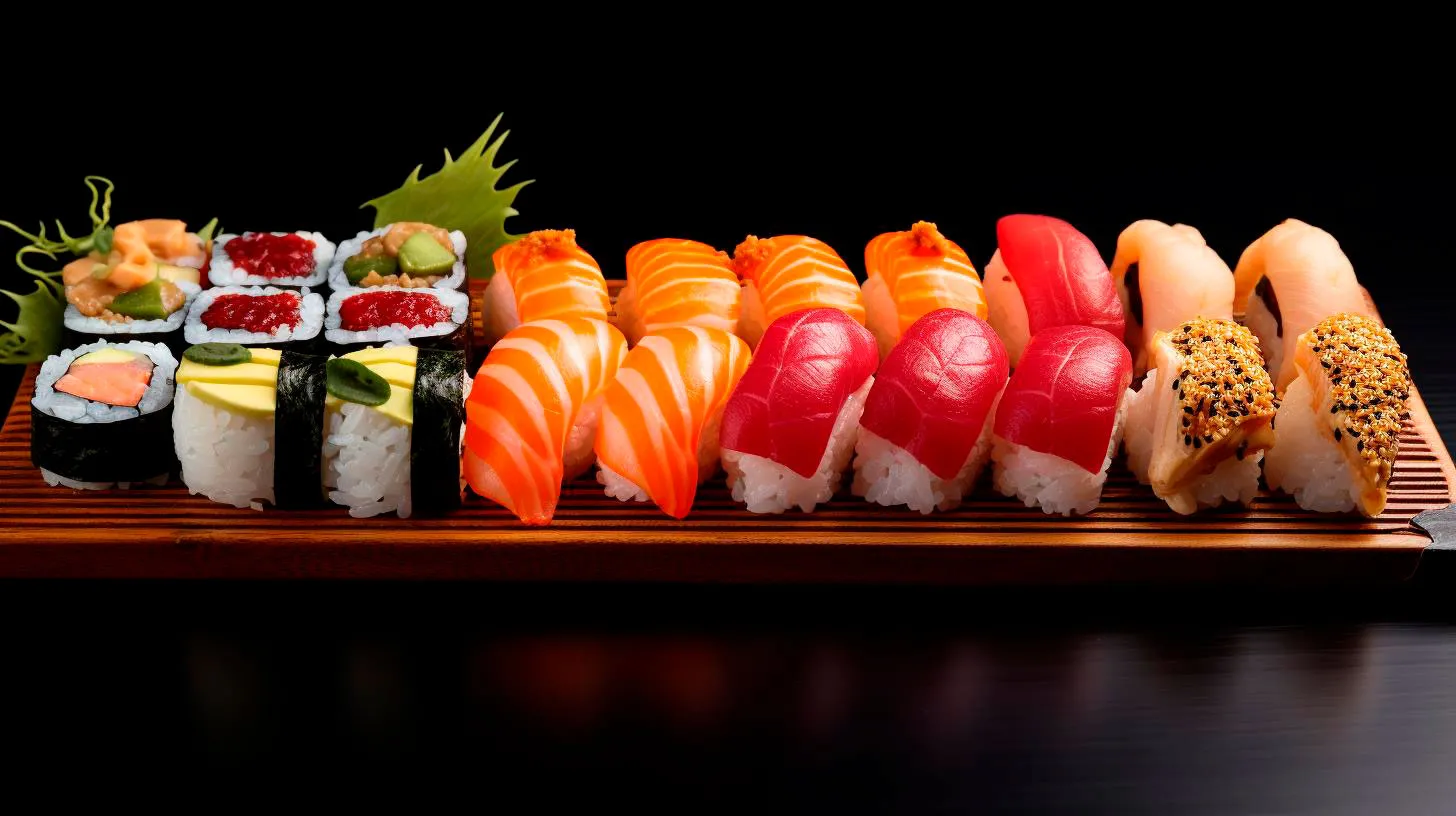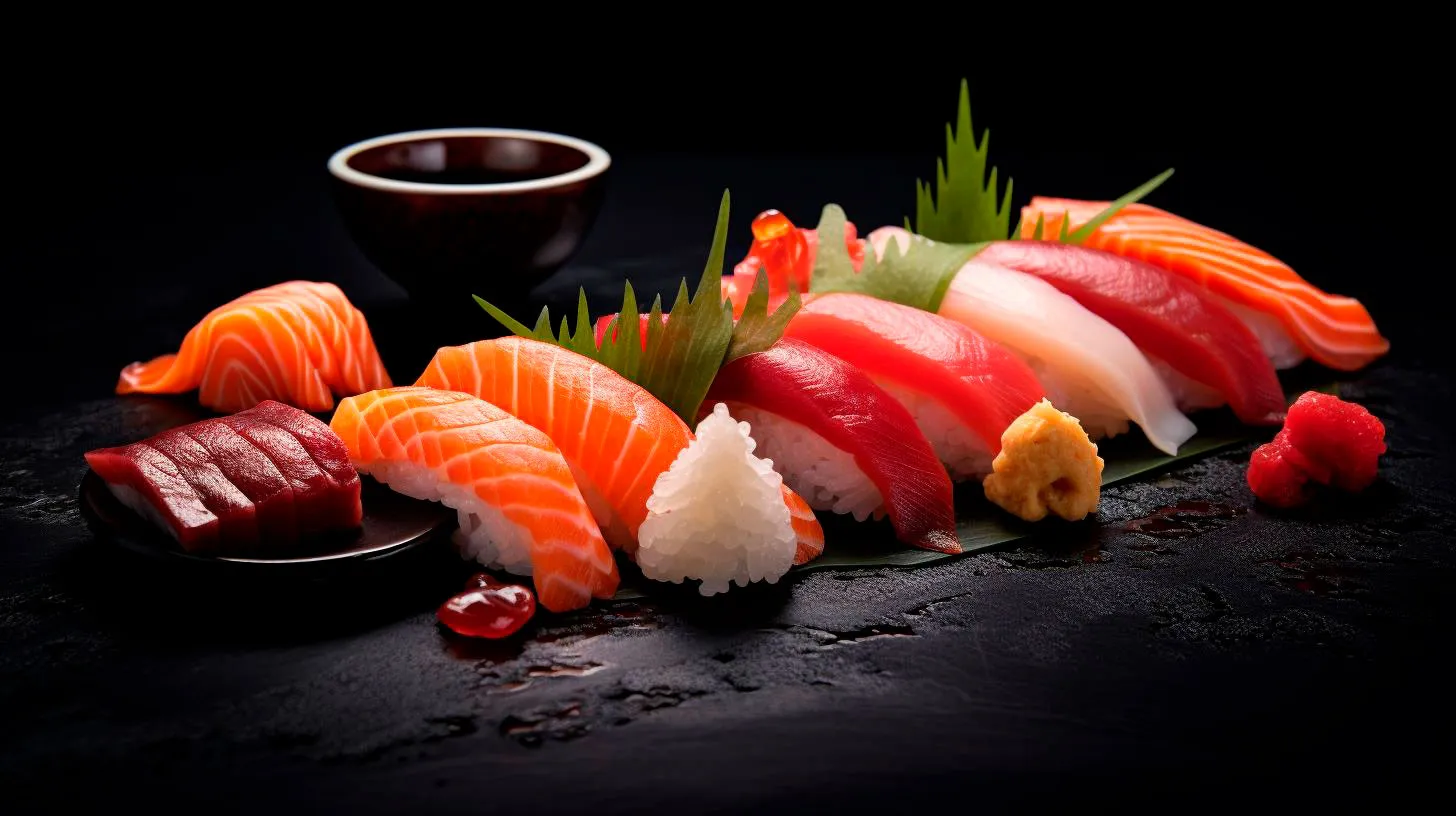Supporting Local and Responsible Sushi Restaurants
The Growing Demand for Sushi
With its unique flavors and visually appealing presentations, sushi has garnered a loyal following worldwide. In fact, the global sushi market is expected to reach a whopping $31.72 billion by 2026, growing at a CAGR of 6.1%. This staggering growth can be attributed to the increasing popularity of Japanese cuisine, as well as the rise in health-conscious consumers.
The Advantages of Supporting Local Sushi Restaurants
While chain sushi restaurants may seem convenient and familiar, there are numerous advantages to supporting local establishments. Let’s explore some of these key benefits:
- Authenticity: Local sushi restaurants often offer a more authentic dining experience compared to chain establishments. They strive to preserve Japanese culinary traditions, providing you with an opportunity to taste genuine flavors.
- Freshness: Local establishments typically source their ingredients from nearby suppliers. This means you can enjoy sushi made with fresh, locally-sourced seafood, ensuring a higher quality dining experience.
- Culture and Community: Local sushi restaurants are often deeply rooted in the communities they serve. By supporting them, you contribute to the growth and vitality of your local economy. Additionally, these establishments often showcase Japanese culture, creating a unique and immersive dining experience.
- Personalized Service: Local sushi restaurants prioritize building strong relationships with their customers. They offer personalized service, getting to know your preferences and providing recommendations tailored to your tastes.
The Importance of Responsible Sourcing
As conscious consumers, it is essential to consider the impact of our food choices on the environment. When it comes to sushi, responsible sourcing is crucial. The declining health of our oceans and the depletion of fish stocks are pressing concerns that need to be addressed. By supporting local sushi restaurants committed to responsible sourcing practices, you can contribute to sustainable seafood consumption.
Here are some key takeaways on why responsible sourcing is important:
- Preserving Ocean Biodiversity: Responsible sourcing helps protect marine ecosystems and promotes sustainable fishing practices, allowing fish populations to replenish and thrive.
- Minimizing Environmental Impact: Sustainable sourcing reduces the carbon footprint associated with transporting seafood over long distances. Supporting local restaurants that prioritize locally caught seafood helps minimize this impact.
- Ensuring Future Generations: By consuming responsibly sourced seafood, you are contributing to the long-term availability of fish and seafood for future generations.
What You Can Do to Support Local and Responsible Sushi Restaurants
Now that we understand the significance of supporting local and responsible sushi restaurants, let’s explore some actionable steps you can take:
- Research Local Establishments: Look for sushi restaurants that prioritize locally sourced ingredients and responsible sourcing. Online reviews and recommendations can help you find these hidden gems.
- Engage in Conversation: Talk to sushi chefs or restaurant owners about their sourcing practices. Ask questions about where they get their seafood and how they ensure responsible sourcing.
- Spread the Word: Share your positive experiences at local sushi restaurants with friends and family. Word-of-mouth recommendations can go a long way in supporting these businesses and encouraging others to do the same.
- Explore Sustainable Sushi Options: Some restaurants offer sustainable sushi options, such as vegetarian or plant-based rolls. Give them a try and expand your culinary horizons.
- Takeaway or Delivery: If dining in isn’t an option, consider ordering takeaway or delivery from local sushi restaurants. By doing so, you continue to support them during challenging times.
Final Thoughts
Supporting local and responsible sushi restaurants is a win-win for everyone involved. Not only do you get to enjoy authentic flavors and fresh ingredients, but you also contribute to the preservation of our oceans and local communities.
So, the next time you crave sushi, remember the impact your choice can have. Choose local, choose responsible, and savor every delicious bite while making a positive impact!
Understanding the Environmental Impact of Sushi
While sushi is undeniably delicious, its production and sourcing methods can have significant consequences for the environment. In this article, we will delve into the key factors contributing to the environmental impact of sushi and explore sustainable solutions that can help mitigate its negative effects.
The Fishing Industry
The fishing industry takes center stage when it comes to the environmental impact of sushi. Overfishing, illegal fishing practices, and bycatch are just a few of the challenges that jeopardize the delicate marine ecosystems. Consider the following key takeaways:
- Overfishing: According to the Food and Agriculture Organization (FAO), approximately 33% of global fish stocks are overfished. This unsustainable practice not only depletes fish populations but also disrupts marine ecosystems.
- Illegal Fishing: Illegal, unreported, and unregulated (IUU) fishing is estimated to represent 20% of global fish catches. These practices contribute to overfishing and can have devastating effects on marine biodiversity.
- Bycatch: Bycatch refers to the unintended catching of non-target species in fishing nets. This can include endangered species, dolphins, turtles, and seabirds. Bycatch is considered as one of the major threats to marine life.
Seafood Sourcing
The sourcing of seafood ingredients, such as fish and shrimp, for sushi also has a significant environmental impact. Sustainable sourcing is an essential factor when considering the ecological footprint of sushi. Consider the following points:
- Aquaculture: The practice of farming fish, known as aquaculture, can be a more sustainable alternative to wild-caught fish. Sustainable aquaculture allows for controlled fish growth and reduced pressure on wild fish populations.
- Responsible Shrimp Farming: Shrimp is a popular ingredient in sushi, but traditional shrimp farming methods have detrimental effects on the environment. Look for certifications like ASC (Aquaculture Stewardship Council) or the Global Aquaculture Alliance Best Aquaculture Practices (GAA BAP) when choosing sustainably farmed shrimp.
- Traceable and Transparent Supply Chains: Knowing where your seafood comes from is crucial in making sustainable choices. Look for sushi restaurants that prioritize transparency and provide information on the sourcing of their seafood.
Waste and Packaging
Another aspect of the environmental impact of sushi lies in the waste generated during production and the excessive packaging often associated with takeout and delivery. Consider the following:
- Plastic Pollution: Single-use plastic packaging, including soy sauce packets and plastic containers, can contribute to plastic pollution in oceans and landfills. Opt for restaurants that use eco-friendly packaging alternatives.
- Reducing Food Waste: Sushi restaurants often strive to present beautiful platters, but this can lead to excessive food waste. Encourage dining establishments to adopt strategies to reduce food waste, such as offering smaller portion sizes or providing takeout containers for leftovers.
- Recycling and Composting: Supporting sushi restaurants that prioritize recycling and composting can contribute to a circular economy and reduce waste sent to landfills.
Choosing Sustainable Options
When indulging in sushi, there are several actions you can take to reduce its environmental impact:
- Opt for Sustainable Fish: Choose sushi made from sustainable fish species, such as Alaskan salmon, which is managed by stringent regulations.
- Support Sustainable Sourcing: Frequent sushi restaurants that prioritize sustainable sourcing practices and promote responsible fishing and aquaculture methods.
- Reduce Disposable Packaging: Choose dine-in options whenever possible to minimize single-use packaging waste. If ordering takeout or delivery, ask for minimal packaging or use your own reusable containers.
- Spread Awareness: Educate others about the environmental impact of sushi and the importance of making sustainable seafood choices.
Conclusion
Sushi is a delightful culinary experience, but we must acknowledge and address its environmental impact. By understanding the challenges associated with the fishing industry, promoting sustainable sourcing, and reducing waste and packaging, we can enjoy sushi while minimizing its ecological footprint. Let’s make informed choices and support sushi establishments that prioritize sustainable practices. Together, we can protect our oceans and ensure a brighter future for sushi and the environment.
The Rising Popularity of Plant-based Sushi Alternatives
The rise of plant-based sushi alternatives is not only changing the way people enjoy this Japanese cuisine but also reshaping the culinary landscape as a whole.
The Plant-based Sushi Movement
Plant-based sushi refers to sushi rolls that are created using a variety of plant-based ingredients instead of fish or seafood. These alternatives are crafted to mimic the texture, appearance, and flavor of traditional sushi. The movement behind plant-based sushi has gained significant momentum in recent years, fueled by the growing interest in vegan and vegetarian diets. People are increasingly seeking healthier and more sustainable food choices, which has led to a surge in demand for plant-based alternatives.
The Advantages of Plant-based Sushi Alternatives
- Health Benefits: Plant-based sushi alternatives are typically lower in calories, saturated fats, and cholesterol compared to their fish-based counterparts. They are often packed with essential nutrients, including vitamins, minerals, and fiber, making them a nutritious choice for those looking to maintain a balanced diet.
- Environmental Sustainability: The fishing industry has a significant impact on marine ecosystems, contributing to overfishing and habitat destruction. Plant-based sushi alternatives help reduce the strain on our oceans and promote environmental sustainability, as they do not require fishing or harm to marine life.
- Ethical Considerations: By choosing plant-based sushi alternatives, individuals can align their dietary choices with their personal ethics. Many people are concerned about animal welfare and the ethical implications of consuming seafood, making plant-based options an attractive choice.
- Increased Accessibility: Plant-based sushi alternatives offer a wider range of options for individuals with dietary restrictions or allergies. They cater to various dietary needs, including vegan, vegetarian, gluten-free, and dairy-free diets, making sushi accessible to a more diverse audience.
The Culinary Journey of Plant-based Sushi Alternatives
The culinary innovation behind plant-based sushi alternatives is truly remarkable. Chefs and culinary enthusiasts have been experimenting with creative ingredient combinations to recreate the unique umami flavor that sushi is renowned for. From using seasoned tofu as a substitute for fish to utilizing vibrant and flavorful vegetables like avocado, cucumber, and sweet potato, plant-based sushi alternatives offer a tantalizing and satisfying culinary experience.
It’s worth noting that plant-based sushi alternatives are not just limited to vegetables. Chefs have also explored using ingredients like mushrooms, jackfruit, and even fruit like mango to create exciting and unexpected flavor profiles. These innovative approaches ensure that plant-based sushi alternatives are not only healthy and sustainable but also incredibly delicious.
The Key Takeaways
- Plant-based sushi alternatives are gaining popularity due to the rise of plant-based diets and ethical considerations.
- They offer various advantages, including health benefits, environmental sustainability, and increased accessibility.
- Chefs are creatively reinventing sushi by using plant-based ingredients to mimic the traditional flavors, textures, and appearance.
- Ingredients like tofu, vegetables, mushrooms, and fruits are utilized to create exciting and flavorful plant-based sushi alternatives.
The rising popularity of plant-based sushi alternatives signifies a significant shift in the culinary landscape, with more people embracing sustainable and ethical food choices. As the demand for plant-based options continues to grow, we can expect further innovation and creativity in the world of sushi. Whether you are a devoted sushi aficionado or simply curious about exploring new culinary horizons, plant-based sushi alternatives offer a delectable and conscious dining experience that is worth indulging in.
Exploring Eco-friendly Fishing Techniques for Sustainable Sushi
However, the good news is that there are eco-friendly fishing techniques that can help ensure the sustainability of sushi and protect our marine ecosystems. In this article, we will explore some of these techniques and their benefits in creating a more environmentally friendly sushi industry.
The Importance of Sustainable Fishing
Before delving into the eco-friendly fishing techniques, it is crucial to understand why sustainability is crucial for the future of sushi and our oceans. According to the United Nations Food and Agriculture Organization (FAO), over 90% of global fish stocks are already fully exploited or overfished. This alarming statistic highlights the urgent need for sustainable fishing practices to preserve marine biodiversity and protect the livelihoods of coastal communities who heavily rely on these resources.
Eco-Friendly Fishing Techniques for Sustainable Sushi
1. Line Fishing: Also known as hook and line fishing, this technique involves using a single fishing line and baited hooks. It is one of the most environmentally friendly methods as it reduces bycatch and allows for selective fishing.
2. Pole Fishing: Similar to line fishing, pole fishing relies on a fishing pole instead of a fishing reel. It is a low-impact technique that results in minimal damage to marine habitats.
3. Trolling: Trolling involves dragging fishing lines with hooks behind a slow-moving boat. This technique allows fishermen to precisely target specific species, reducing the chance of bycatch.
4. Purse Seining: Purse seining utilizes a large net deployed around a school of fish, which is then drawn shut at the bottom to capture the fish. However, sustainable purse seining methods include using fish aggregating devices (FADs) that minimize bycatch.
Benefits of Eco-friendly Fishing Techniques for Sushi
Adopting eco-friendly fishing techniques for sushi production offers numerous benefits:
- Preserving Marine Biodiversity: By reducing bycatch and promoting selective fishing, eco-friendly techniques help protect non-target species and maintain a healthy marine ecosystem.
- Sustaining Fish Stocks: Sustainable fishing practices ensure the long-term availability of fish stocks, supporting the livelihoods of fishermen and the seafood industry.
- Reducing Environmental Impact: Eco-friendly techniques cause minimal damage to marine habitats, preserving fragile ecosystems and safeguarding the overall health of our oceans.
- Consumer Preference: As consumers become more conscious of the environmental impact of their food choices, sustainable sushi options are increasingly in demand.
Key Takeaways
1. Sustainable fishing techniques such as line fishing, pole fishing, trolling, and purse seining with FADs are crucial for the sustainable production of sushi.
2. Overfishing and damaging fishing practices pose a significant threat to marine biodiversity and the livelihoods of coastal communities.
3. Adopting eco-friendly fishing techniques helps preserve marine ecosystems, sustain fish stocks, and reduce the environmental impact of sushi production.
4. Consumer demand for sustainable seafood options is growing, emphasizing the need for the sushi industry to embrace eco-friendly practices.
In conclusion, by transitioning to eco-friendly fishing techniques, the sushi industry can play a significant role in preserving our oceans and ensuring a sustainable future for this beloved delicacy. It is essential for consumers, fishermen, and policymakers to join forces and support initiatives that prioritize sustainable fishing practices. By doing so, we can continue to enjoy sushi while actively contributing to the health and well-being of our marine ecosystems.


